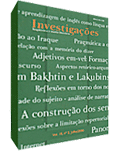A Influência do Português como Língua Materna no Processo de Aprendizagem de Inglês como Língua Estrangeira: A Questão do Sujeito Gramatical
Resumo
Neste artigo, resumimos a dissertação de mestrado de Canato, sob a orientação de Durão, que descreve os resultados obtidos em uma pesquisa realizada com aprendizes de inglês. A pesquisa teve por objetivo verificar a influência da língua portuguesa como língua materna no processo de apresentação de língua inglesa como língua estrangeira, no que concerne à questão do sujeito gramatical. Partimos do pressuposto de que os aprendizes teriam dificuldades quanto a este uso em aspectos em que as línguas se diferenciamReferências
AKMAJIAN, Adrian... [et. Al]. 1998. Linguistics: an introduction to language and communication. 4th. Ed. Massachusetts: Institute of technology.
CANATO, Ana Paula Marques Beato. 2003. A influência da língua materna/ primeira língua no processo de aquisição/ aprendizagem de língua estrangeira/ segunda língua: a questão sujeito gramatical. Londrina. Dissertação (mestrado em Estudos da Linguagem) – Centro de Ciências e Letras, Universidade Estadual de Londrina.
CORDER, S. P. 1967. The significance of Learners’ Errors. IRAL, V/4:161-170.
CYRINO, Sonia Maria Lazzarini. 1986.The Pro-drop parameter and second language acquisition.101 f. Dissertação (Mestrado — Universidade de Iowa, Iowa).
DUARTE, Maria Eugênia Lamoglia. 1996. Do pronome nulo ao pronome pleno: a trajetória do sujeito no português do Brasil. In: KATO, Mary A.; ROBERTS, Ian. Português Brasileiro: Uma viagem diacrônica. Campinas: Editora da Unicamp.
DURÃO, Adja Balbino de Amorim Barbieri. 1999. Análisis errores e interlengua de brasileños aprencides de español y de españoles aprendices de portugués. Londrina:Editora da UEL.
ELLIS, Rod. 1986. Understanding Second Language Acquisition. Oxford: Oxford University Press, 326p.
FIGUEIREDO, Francisco José Quaresma de. 1997. Aprendendo com os erros: Uma perspectiva comunicativa de ensino de línguas. Goiânia: UFG, 137p.
FISIAK, Jacek. 1981. Some introductory notes concerning Contrastive
Linguistics. Contrastive Linguistics and the language teacher. Oxford: Pergamon Press Ltd.
JAMES, Carl. 1983. Contrastrive Analysis. Inglaterra: Longman.
LADO, R. 1957. Linguistics Across Cultures. Ann Arbor, University of Michigan Press.
OLIVEIRA, Marilza de. 1999. O parâmetro do sujeito nulo na aquisição da
linguagem. Cad. Est. Ling., Campinas, (36):131-145, Jan./Jun.
RUTHERFORD, William E. 1989. Second language grammar: learning and
teaching. Longman.
SALINAS, Ma. Del Pilar López. 2001. Estudio y análisis de errores de la
interlengua de español para anglófonos. Forma 2: interferencias, cruces y errores. Madrid: SGEL, p.101-117.
SANTOS, Angela Maria Bravin dos. 2001. O sujeito pronominal em contexto de mudança paramétrica: a escrita de alunos do Ensino Médio. Signum: Estudos da Linguagem, Londrina, n.4, p. 221-240, dez.
SELINKER, L. 1969. Language Transfer. General Linguistics, 9/2:67-92,
Binghamton.
______. 1972. Interlanguage. Iral, X/3:209-231.
SIMÕES, Luciene Juliano. 1999. Sujeito nulo na aquisição do português do Brasil. Cad. Est. Ling., Campinas, (36):105-130, Jan./Jun.
Downloads
Publicado
Como Citar
Edição
Seção
Licença
Copyright (c) 2005 Adja Balbino de Amorim Barbieri Durão, Ana Paula Marques Beato Canato

Este trabalho está licenciado sob uma licença Creative Commons Attribution 4.0 International License.
Autores que publicam na Revista Investigações concordam com os seguintes termos:
Autores mantêm os direitos autorais e concedem à revista o direito de primeira publicação, com o trabalho simultaneamente licenciado sob a licença Creative Commons Atribuição 4.0 Internacional (CC BY 4.0) que permite o compartilhamento do trabalho com reconhecimento da autoria e publicação inicial nesta revista.
Autores têm autorização para assumir contratos adicionais separadamente, para distribuição não-exclusiva da versão do trabalho publicada nesta revista (exemplo: depositar em repositório institucional ou publicar como capítulo de livro), com reconhecimento de autoria e publicação inicial nesta revista.
Qualquer usuário tem direito de:
Compartilhar — copiar e redistribuir o material em qualquer suporte ou formato para qualquer fim, mesmo que comercial.
Adaptar — remixar, transformar e criar a partir do material para qualquer fim, mesmo que comercial.
O licenciante não pode revogar estes direitos desde que você respeite os termos da licença.
De acordo com os termos seguintes:
Atribuição — Você deve dar o crédito apropriado, prover um link para a licença e indicar se mudanças foram feitas. Você deve fazê-lo em qualquer circunstância razoável, mas de nenhuma maneira que sugira que o licenciante apoia você ou o seu uso.
Sem restrições adicionais — Você não pode aplicar termos jurídicos ou medidas de caráter tecnológico que restrinjam legalmente outros de fazerem algo que a licença permita.

